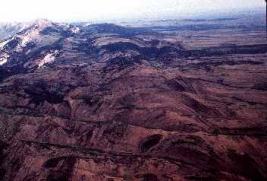FoldingWhen rocks deform by plastic deformation they can bend and
fold. The process of folding occurs when rock is compressed,
as it is along colliding plate boundaries. Upturned folds are called
anticlines
Figure 15.24 Components of a Fold
Symmetrical or open folds with their near-vertical axial planes and gently dipping limbs of about the same angle are a product of gentle compression. Symmetrical folds are found near the margins of mountain systems where tectonic activity is relatively quiet. If the compression is more pronounced from one direction, an overturned fold may occur. Extreme directed pressure may lay the fold over with its axial plane nearly horizontal with the surface producing a recumbent fold. Sometimes the length of the folds are tilted creating plunging folds. One of the best examples of folded topography is the Appalachian mountains found in the Ridge and Valley physiographic province of North America.
|
|
|
Figure 15.25 Teton Anticline, Utah |
Figure 15.26 Syncline in Lockhart Basin, Utah |
|
|
|



